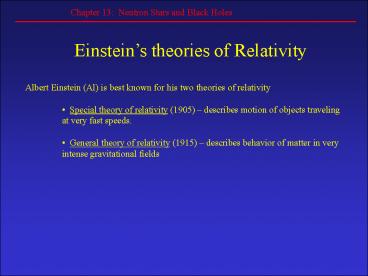Einsteins theories of Relativity - PowerPoint PPT Presentation
1 / 15
Title:
Einsteins theories of Relativity
Description:
Special theory of relativity (1905) describes motion of ... Some very nice movies/simulations about black holes: http://ganesh.colorado.edu/nelson/sg.html ... – PowerPoint PPT presentation
Number of Views:48
Avg rating:3.0/5.0
Title: Einsteins theories of Relativity
1
Einsteins theories of Relativity
- Albert Einstein (Al) is best known for his two
theories of relativity - Special theory of relativity (1905) describes
motion of objects traveling at very fast speeds. - General theory of relativity (1915) describes
behavior of matter in very intense gravitational
fields
2
Special theory of Relativity
Proposed in 1905 to support the observations of
A.A. Michelson and E. W. Morley that the measured
speed of light is independent of the motion of
the observer or source. No matter what our speed,
we always measure the speed of light as
299,792.458 km/s.
3
- The special theory of relativity allows us to
extend our laws of Physics from low speeds to
speeds approaching the speed of light. - Some predications
- Moving objects appear to contract in direction
of motion - Moving clocks run slow
- Mass increases
- All predictions have been repeatedly verified to
very high accuracy.
4
General theory of relativity
General relativity explains what gravity is and
how it fits in the special relativity
framework. It equates gravity to accelerating
reference frames. You cant tell the difference.
There is no experiment you could perform to tell
the difference except looking outside.
5
To incorporate accelerating frames into special
relativity, Einstein had to treat time just like
he treated space and thus our new coordinate
frame is called space-time. It is a four
dimensional space. Thus matter curves space-time
and objects follow that curvature and we call the
effect Gravity.
Newtonian view particles move in curved
trajectories due to the force of
gravity. Relativistic view particles move in
curved trajectories following the curve of space
produced by nearby mass.
6
The gravitational field around an object is like
pulling a rubber sheet. If you pull too hard
that part of it gets pinched off form the rest of
the universe.
7
- What explanation does general relativity provide
for gravity? - a. Gravity is a result of curved spacetime.
- b. Gravity is directly proportional to mass.
- c. Gravity is inversely proportional to the
radius of the universe. - d. all of the above
- e. none of the above
8
Consequences of Relativity Theories
The study of black holes
Let us suppose we get funding to send an unmanned
space probe towards a black hole. The probe will
radio back information like temperature, time,
etc.
9
We discover that as the spacecraft approaches the
black hole, the frequency we have been
communicating with slowly changes to a lower
frequency. This is because the light losses
energy as it tries to escape from the region
around the black hole. As time goes on the
frequency shifts so low we can no longer
communicate with it. It has slipped past the
event horizon.
10
We also notice that has the probe approaches the
black hole, the time reported back continues to
be slow. It is as if we are aging faster than
the probe is. This is called time dilation. As
the probe enters the event horizon it appears
that its clock slows to a stop and we never
actually see the probe enter the horizon.
11
The extra amount of precession of planet
Mercurys orbit is explained by GTR. The
bending of light by gravity is predicted
12
Gravity from other galaxies bend the light from
other galaxies to form Einstein rings and crosses.
13
- If the sun were to be replaced by a one solar
mass black hole, the gravitational pull of the
black-hole sun upon the Earth would be - a. much greater
- b. the same
- c. much less
- d. none of these
14
- Which of the following are attracted by gravity?
- a. any object with mass
- b. electromagnetic radiation
- c. neutrinos
- d. all of the above
- e. none of the above
15
- View of sky while orbiting a black hole
- http//www.netspace.net.au/gregegan/PLANCK/Tour/T
ourApplet.html - Some very nice movies/simulations about black
holes - http//ganesh.colorado.edu/nelson/sg.html































